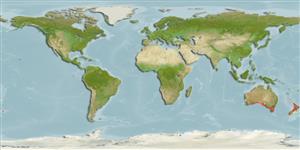Common names from other countries
Environment: milieu / climate zone / depth range / distribution range
Ecología
marino demersal; rango de profundidad 20 - 200 m (Ref. 9563). Temperate; 29°S - 47°S, 113°E - 176°W
Indo-West Pacific: New Zealand and Australia (southern Western Australia to New South Wales and Tasmania).
Tamaño / Peso / Age
Maturity: Lm ? range ? - ? cm
Max length : 31.0 cm TL macho / no sexado; (Ref. 9563); common length : 25.0 cm TL macho / no sexado; (Ref. 9258)
Short description
Claves de identificación | Morfología | Morfometría
Espinas dorsales (total) : 2; Radios blandos dorsales (total) : 32 - 38; Radios blandos anales: 31 - 36. Scales small with numerous tiny spinules, prominent first dorsal spine above eyes (Ref. 9002).
Inhabits rocky weedy areas from the shore to at least 60 m. Generally solitary but may aggregate in groups of 10-15 individuals in midwater. Feeds mainly on sessile and encrusting organisms, with sponges and ascidians predominating (Ref. 26966); also seen feeding mid-water on zooplankton and likes to bite diver's fingers (Ref. 9002).
Life cycle and mating behavior
Maturities | Reproducción | Spawnings | Egg(s) | Fecundities | Larva
Armitage, R.O., D.A. Payne, G.J. Lockley, H.M. Currie, R.L. Colban, B.G. Lamb and L.J. Paul (eds.), 1994. Guide book to New Zealand commercial fish species. Revised edition. New Zealand Fishing Industry Board, Wellington, New Zealand, 216 p. (Ref. 9258)
IUCN Red List Status (Ref. 130435)
CITES (Ref. 128078)
Not Evaluated
Threat to humans
Harmless
Human uses
Pesquerías: comercial
Herramientas
Special reports
Download XML
Fuentes de Internet
Estimates based on models
Preferred temperature (Ref.
115969): 13.4 - 17.7, mean 15.1 (based on 141 cells).
Phylogenetic diversity index (Ref.
82804): PD
50 = 0.5039 [Uniqueness, from 0.5 = low to 2.0 = high].
Bayesian length-weight: a=0.02754 (0.01477 - 0.05134), b=2.97 (2.81 - 3.13), in cm Total Length, based on LWR estimates for this species & (Sub)family-body (Ref.
93245).
Nivel trófico (Ref.
69278): 3.1 ±0.0 se; based on diet studies.
Resiliencia (Ref.
120179): Medio, población duplicada en un tiempo mínimo de 1.4-4.4 años (Assuming tm=2).
Fishing Vulnerability (Ref.
59153): Low to moderate vulnerability (27 of 100).
Climate Vulnerability (Ref.
125649): Moderate to high vulnerability (49 of 100).
